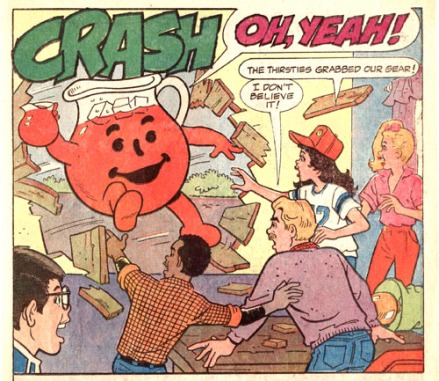This last week we did “Grace” at our gym.
“Grace” is a nasty little workout where the athlete performs 30 clean and jerks as quickly as possible at a weight of 135 pounds for men and 95 pounds for women. It can be a slow grind or an unabashed sprint and I had every intention of achieving the latter. While I spent almost all day visualizing the bar moving up and down from the floor to overhead, I spent almost no time thinking about the possibility of “Rhabdo.”
Rhabdomyolysis or “Rhabdo” as the Internets likes to call it is the breakdown of muscle fibers that leads to the release of myoglobin into the bloodstream where it can wreak havoc on the kidneys and other parts of the body. It can be the result of dozens of causes, but for the purpose of this post, physical over exertion is one of them.
During the workout, I tried so intensely to keep ahold of the bar that my forearms went from an aching pain to a dull numbness that screamed, “LET GO OF THE BAR.” Which I did, after 26 unbroken reps. I continued knocking out the last 4 reps as singles and ended with a time of 1:43, which was by far the hardest I’ve pushed myself in any workout ever.
Whatever fitness science/magic that needed to happen occurred about 15 seconds after finishing the workout as my body caught up with the unusual effort I had asked of it. Breathing was a chore and my arms felt likely useless weights attached to my torso. I was a mess.
After a few minutes, everything seemed to equalize and get back under control, I was able to break down my bar and head on home with my wife. I took a shower, had dinner, went to sleep, classic CrossFit stuff.
The next morning, I woke up with a strange sensation. I was tingly and lightheaded, I turned to my wife and yelled, “Yo, I CRUSHED that WOD yesterday!” Because that’s how I talk when nobody’s around.
Everything was fine. I could still grab a knife to butter my Strawberry Pop Tart, I could still stand in the shower and ruin “Bye, Bye, Bye,” and I was still able to go work out at the gym. Later that day, I came across the article, “CrossFit’s Dirty Little Secret” serendipitously being shared via The Facebooks a day after I made my limit pushing effort during the workout. While I know everything that could be said has been said on the subject of Rhabdomyolysis and CrossFit, my overly-inflated sense of self worth says I should probably chime in with my take on “Uncle Rhabdo” as I’ve heard absolutely no one ever refer to it as.
1. Rhabdomyolysis will savagely rabbit punch everyone you know and care about.
I’ve been CrossFitting for about 16 months now and I have yet to hear a first hand account from anyone who’s suffered “Rhabdo.” I understand that’s a terrible population subset (anyone who’s gotten Rhabdomyolysis is unlikely to return to CrossFit), though I’ve also never met anyone with even a second hand account of anyone who’s gotten Rhabdo. This includes talking to CrossFitters who have 4+ years of experience coaching CrossFit, as well as long time members in multiple gyms in multiple geographical locations around the country. Yes, I asked. Awkwardly and mid-conversation.
This isn’t to say that Rhabdomyolysis is not a risk of CrossFit. It is absolutely a risk of CrossFit. Just like Rhabdomyolysis is a risk of Triathlons or High School Football. Just like Decompression Sickness is a risk of Scuba Diving. Just like Structural Damage is a risk of Thirst.
And while an anecdotal story about a friend of the author certainly shows the ferocity of the condition and its terrible repercussions, I’d be cautious in making the jump that CrossFit causes Rhabdo. Much in the same way that I’d be cautious to say that Scuba Diving causes Decompression Sickness. It’s a risk, and based on my equally anecdotal experience, a starkly low risk. CrossFit is very up front about that risk and makes an effort to educate athletes and coaches. It’s an integral part of the L1 course and you can find plenty of articles (examples here and here) on the CrossFit Journal. It’s not a “dirty little secret” as the article describes. It’s a well documented and oft talked about subject in CrossFit, we’re not trying to spirit it away.
And while the terrifying reality of muscles breaking down and poisoning your body is certainly a jarring concept, the brutal nature of Rhabdomyolysis doesn’t somehow make it more common.
2. It’s not your fault. It’s not your fault. It’s not your fault. (Matt Damon cries.)
Eric Robertson wrote a follow up piece to his initial “Secrets” post, “I didn’t Shoot John Lennon.” In it, he mentions that a largely supported rebuttal to his first article is “personal responsibility,” the idea that many CrossFitters believe the athlete should have an understanding of the inherent risks of intense exercise and understand how to mitigate those risks through education and not letting their ego get the best of them.
While I agree that education on the subject is incredibly important and that athletes need to understand their limits, I also understand that I go to CrossFit to push those limits. I spent all day preparing myself for the devastation I would go through during “Grace” and I pushed myself harder than I can recall doing in my recent past. I also didn’t get Rhabdo. But maybe I could have. And then maybe I wouldn’t have suckered you into reading this post with its misleading title.
Rhabdomyolysis can be the result of bad programming or poor coaching. It can also be the result of poor decisions made by the athlete. It can also be a thing that happens. Just a thing. That happens. Like Lil Wayne or the Teletubbies. Not anyone’s fault. Just the result of an athlete pushing themselves slightly too far during a workout that 99.9999% of the time would be perfectly normal and sane.
This happens all the time in normal non-CrossFit life. Driving is statistically a terribly dangerous activity to participate in. Especially compared to using public transportation (buses are 170 times safer than riding in a car according to the National Safety Council). But I do it literally all the time. I find that it fits my transportation needs quite well and despite the inherent risk I will continue to do it. I could certainly get into an accident. It might be the other driver’s fault. It might even be my fault. Or it could just be a thing that happens. And that would be terrible.
As I’ve shamelessly plugged on my blog before, CrossFit is not for everyone and if the incredibly small chance of Rhabdomyolysis is enough to turn you away from this particular form of fitness, that’s totally okay. I get it. There are other options available with perhaps less risk/intensity or that maybe fit your goals a bit better. If the level of intensity available to you through CrossFit is what you desire and you accept that Rhabdo is a thing that could potentially occur in the most minute of circumstances then that’s cool too. But let’s not pretend that this is something that I need to constantly be brooding over and concerned with every time I do 100 push ups and my arms get sore.
3. So wait… Did CrossFit break the Internet?
It’s incredible to me how excited the internet gets about CrossFit. I’m not sure everyone’s quite caught that Rhabdomyolysis is not a new disease invented by CrossFit. I used to run a few Triathlons and longer endurance runs and I never heard anyone talk about Rhabdo and its causes/symptoms. And not because it wasn’t a risk. It was just something people didn’t talk about. Though to be fair, I also didn’t seek out information on potential hazards of running Triathlons.
CrossFit is exposing a larger population to a form of exercise that is much more “intense” than many of us are used to. Creating that level of intensity on this massive of a scale means that the larger population is not only able to reap the benefits of the program but is also exposed to some of the risk that is associated with that particular level of fitness.
The upside to all this online conflict is that more athletes are getting involved with the Rhabdo discourse, even when much of it is thinly veiled “I love CrossFit/I hate CrossFit” talk (present blog included). My wife is way more interested in reading about Rhabdomyolysis today than she’s been in the past year and that’s awesome. All CrossFit athletes (and athletes generally) should have a good understanding of Rhabdo and it’s causes, symptoms, and remedies. Just don’t make the assumption that if something can happen it will happen. It’s like the worst kind of lottery ticket.







I love it.
You’re my Channing Tatum.
It was the picture of Channing Tatum that caught my attention then the title. Shameless, I know.
Well, he’s a pretty handsome gentleman.
When does this go on the Huffington Post??
Eh, not everything I touch is gold.
Well said, Max. I believe that I see two fundamental truths behind this whole “controversy”.
1) Basic Science. CORRELATION DOES NOT IMPLY CAUSATION.
2) Follow the money. It would be my educated guess that the greatest reason this exploded online is the natural pushback by the entrenched and very profitable fitness industry to the explosive growth of CrossFit.
1) ABSOLUTELY. This can sometimes be a massive hurdle for my brain.
2) I love conspiracies.
Great post! I’m not a Cross Fitter, but I am an athletic trainer, and have dealt with some of my athletes getting Rhabdo. You are right, it can “just happen” to some people. Earlier this summer, I actually had an athlete who did a max bench day, and ended up with Rhabdo — this was a normal lifting day, not some crazy CrossFit work-til-you-die type of workout. I think that people should be aware of the risks, but I also think that you’re absolutely right that CrossFit does not “cause” rhabdo. Plus, you made me laugh, so I appreciate that 🙂
Right on! Yes, there’s far more factors that influence whether or not Rhabdo becomes a part of your life than CrossFit. Dehydration, heat, the list seems to go on and on. It sounds terrible and I hope I’m able to avoid getting it, ever. Thanks for checking out the blog!
I agree with the reasons listed for Rhabdo. So, I got some grief about Crossfit, Rhabdo, etc (I also Crossfitted my entire pregnancy-Got grief for that as well) and I finally sent my uncle this list
“Rhabdomyolysis has many causes. Some of the common ones include:
muscle trauma or crush injury,
severe burns,
physical torture or child abuse,
prolonged lying down on the ground (people who fall or are unconscious and are unable to get up for several hours),
prolonged coma,
severe muscle contractions from prolonged seizures,
cocaine use with related hyperthermia (increased body temperature),
extreme physical activity (running a marathon),
drug and alcohol intoxication,
low circulating phosphate, potassium, or magnesium levels in the blood (electrolytes),
genetic muscle diseases (familial paroxysmal rhabdomyolysis),
prolonged drowning or hypothermia (low core body temperature),
medications: most notably statins used to treat high cholesterol
variety of viruses and some bacteria,
severe hypothyroidism (low thyroid level), especially if the person is also taking statin drugs for cholesterol,
…and the list goes on obviously
”
and i said “dude, look at what the exercise listed under ‘extreme physical activity’ is. IT’S RUNNING A MARATHON. Which YOU have been doing for over 20 years now. So who is more likely to get Rhabdo..you or me?”
That shut him right up. Debate win.
Hi there, while you make some good points, i have been an avid crossfitter for almost 2 years and have just been released from a week in the hospital after getting rhabdo from 14.5. Yes you can say its my fault for pushing myself too far, but then you also say thats what we are trained to do. Just be careful with what you remark as I knew the risks of rhabdo, i also thought it was so rare and uncommon that it would NEVER happen to anyone I know, let alone me, but it did, and it does. And trust me, it sucks.
Georgia, I too suffered a hospital stay with Rhabdo after 14.5 and have been training the previous 2 years with great success. NEVER would have imagined during that workout what was happening internally to my muscles. It’s very frustrating when people say that we are “idiots” or “did this to ourselves” as most of the people who experienced this after 14.5 are Crossfit certified trainers and elite athletes. The assumption that some new low-level fitness person would “happen” upon this frustrating and frightening reality is less accurate than that of a trained athlete with lots of mental and physical strength to push through. Personally, I believe the programming of 14.5 engaged the athletes in movements that further increased the risk as burpees and thrusters with that many reps never gave the triceps a break. I’ve heard of at least 4 cases of rhabdo post 14.5 and can’t help but believe this was not a coincidence. I’m completely a DEFENDER of Crossfit, as it has truly been a community of life and love for not only sport, but also people. I think, however, there might be some gain in Crossfit actually assessing the number of cases as a result of games programming just to see if they notice a trend. We are not going to abandon a community, and I look forward to rebuilding, but it is emotionally a struggle knowing that my body showed no sign of pushing any harder than other WODs, and I ended up with a crazy amount of hospital bills and pain. The mental frustration of having to start over completely after working so hard to condition for the games is going to be the most difficult part for sure.
Hi Lauren, I totally agree with you, is there anyway I can get in touch with you to discuss your experience? (email/fb), let me know. Thanks Georgia 🙂
Georgia. Feel free to connect! My email is lauren@myrelationshipcenter.org.
Hi Lauren, that email isn’t working – mine is georgiacoyte@gmail.com if you want to flick me one?
Interesting. I stopped reading your article after you said you didn’t actually have Rhabdo because I DID GET RHABDO. Fitness has always been a priority in my life. I had been doing crossfit for nearly 2 years and I didn’t push myself any harder than usual. I did do 2 days in a row of intense arm work. No big deal. I can do anything, right? I’m a crossfitter. Wrong. The workout that did it to me was Pullups (100 of them total), running and thrusters. I wasn’t unusually sore and I had no symptoms other than my arms being swollen. No dark urine, no weakness, no nausea
My mom found the “crossfit’s dirty little secret” article and that is the only reason I even “INSISTED” my doctor check my CK levels because she wanted to send me home and see if the swelling got worse the next day. That afternoon I was in the ER and spent 3 days in the hospital. It was kinda fun at first being that it was my first time in the hospital and I got IV’s and stuff, but it’s not fun now that I still don’t understand it.
I am now trying to figure out how to work out so I don’t get it again. I’m pretty sure stretching and massage is what actually triggered it and I am also pretty sure I would have it now if I massaged or stretched my legs that have been killing me for a week after my first cardio sculpting class since Rhabdo.
Are there Doctor’s that specialize in this? It is so annoying.